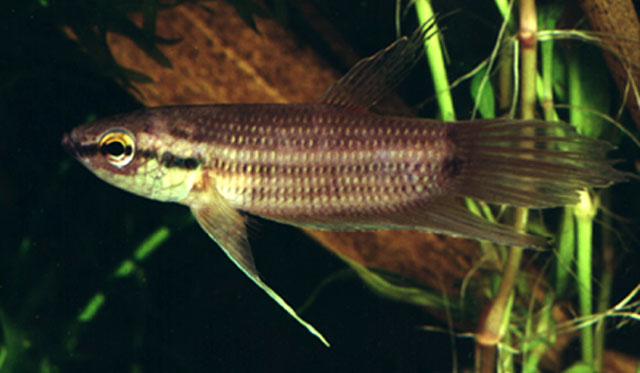| Osphronemidae (Gouramies), subfamily: Macropodusinae |
| 4.48 cm SL (male/unsexed) |
|
benthopelagic; freshwater |
| Asia: presently known only from Banka, Indonesia. |
|
Dorsal spines (total): 2-2; Dorsal soft rays (total): 8-9; Anal spines: 2-4; Anal soft rays: 23-25. Distinguished from other members from Sumatra, Indonesia in the following characters: more anal fin rays (27 vs. 23-25); more dorsal fin rays than Betta cracens and Betta fusca (10-11 vs. 8-9); more subdorsal scales than Betta cracens and B. fusca (6 1/2-7 vs. 5 1/2-6); more lateral scales than B. fusca (31 vs. 29); fewer lateral scales than Betta cracens (31 vs. 32-33); fewer predorsal scales than Betta cracens, Betta fusca and Betta raja (17-19 vs. 20-24); greater head length than Betta pugnax, Betta cracens and Betta fusca (35-.5-36.5% SL vs. 27.5-35.2); smaller predorsal length than Betta fusca (62.7-66.3% SL vs. 68.5-70.2); greater preanal length than Betta cracens (47.8-50.9% SL vs. 42.0-46.1); greater body depth than Betta cracens (26.7-27.6% SL vs. 21.2-24.2); greater dorsal fin base length than Betta cracens (12.4-13.9% SL vs. 10.5-11.6); smaller anal fin base length than Betta cracens (50.4-52.0% SL vs. 53.4-55.7); greater orbital diameter than Betta cracens and Betta fusca (61-76% postorbital length vs. 47-58) (Ref. 56386). |
| Found in forest swamp, peat swamp and hill stream. |
|
Endangered (EN); Date assessed: 07 January 2019 (B1ab(iii)) Ref. (130435)
|
| harmless |
Source and more info: www.fishbase.org. For personal, classroom, and other internal use only. Not for publication.
